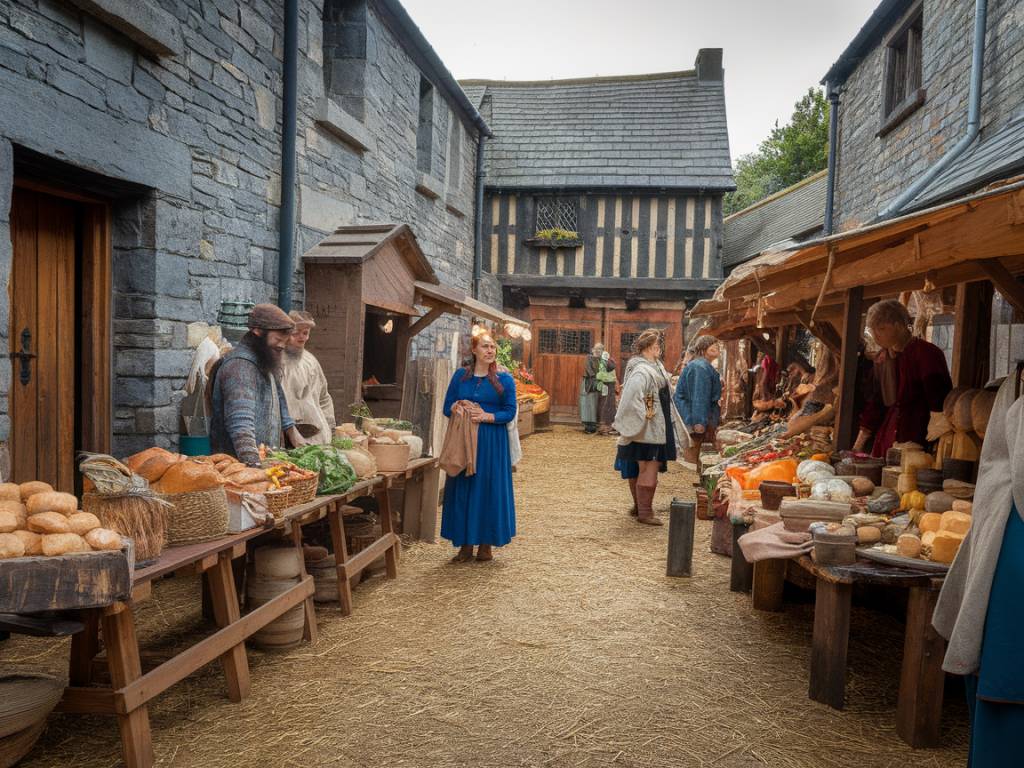When we imagine medieval Wales, our minds might drift to images of imposing stone castles, valiant knights, and sweeping green valleys. But nestled within this romanticized picture lies a less dramatic yet vital scene: the bustling medieval market. These markets were far more than simple trading posts. They were vibrant hubs of activity that significantly shaped the development of Welsh towns, culture, and even daily life. Let’s take a closer look at just how important these markets were in medieval Wales and what remnants of them can still be seen today.
The Rise of Medieval Markets in Wales
During the medieval period, the emergence of markets was a transformative force across Europe, and Wales was no exception. In the 12th and 13th centuries, as towns began to grow and the feudal system evolved, markets became essential for the economic and social fabric of Welsh communities.
Most markets in Wales were established under charters granted by local lords or the Crown. These charters often provided exclusive rights to host a market on particular days, ensuring that trade flourished in specific towns. For example, the market town of Montgomery was granted its charter in 1227, solidifying its place as a regional hub for commerce.
A market wasn’t just a place to barter for cheese or iron tools; it was a strategic asset. Lords saw markets as a means to generate revenue through tolls, and townspeople saw them as opportunities to connect with merchants from near and far. These markets laid the groundwork for many of the thriving Welsh communities we know today.
What Made Medieval Markets So Vital?
So, why were medieval markets more than just a way to stock the pantry? Well, for one, they served as melting pots of culture and knowledge. Farmers, artisans, and traders from various regions—and even countries—would gather to exchange not just goods, but stories, innovations, and ideas.
Imagine a bustling town square filled with the scent of freshly baked bread, the clang of blacksmiths hammering metals, and the chatter of traders hawking their wares. From wool and livestock to spices and pottery, these markets offered an extraordinary range of goods. Imported items, such as wine from Gascony or fabrics from Flanders, brought a hint of the wider world to Welsh markets, reinforcing Wales’ connection to global trade networks.
Beyond tangible goods, these markets also solidified a sense of community. They were social events, places where news was shared, alliances were formed, and sometimes even disputes were settled. In many ways, the medieval market was the heartbeat of a town, keeping it alive and resilient.
Shaping Welsh Towns: A Legacy of Planning and Growth
One of the most fascinating aspects of medieval markets is how they physically shaped the towns around them. In many cases, a market would serve as the focal point of the town, with streets organically growing around the central square.
Take, for instance, Ruthin, a classic example of a medieval market town. The town’s central square, Market Street, served as the nucleus of activity. Surrounding streets developed to accommodate inns, workshops, and homes for merchants. Even today, the layout of these towns tells the story of their market-driven beginnings.
In some cases, entirely new settlements were created with markets in mind. Edward I’s « new towns, » such as Conwy and Caernarfon, were deliberately designed with market squares as focal points, nestled within the protective walls of these fortified towns. This dual function—economic and defensive—highlighted the importance of markets in medieval society.
Market Days: A Feast for the Senses
Market days were lively affairs that could feel almost like festivals. Picture the vibrant stalls, brightly dyed fabrics, and sizzling street foods of today’s fairs, and then imagine their medieval counterparts. It wasn’t uncommon for these events to include entertainers like minstrels, jugglers, and even performing animals, adding an element of spectacle to the day’s trading activities.
Merchants would often travel long distances to attend popular Welsh markets. They would bring essential goods like salt and iron, as well as more luxurious items like exotic spices and fine cloth, which were highly sought after. Local farmers and craftspeople, in contrast, might bring livestock, fresh produce, and handmade items to sell or trade.
But these events weren’t just about business. For many medieval people, market day was a rare opportunity to connect with others. Whether you were hearing gossip, negotiating prices, or watching performers, the markets were social glue for the communities they served.
Modern Traces of Medieval Markets
The legacy of medieval markets is still palpable in Wales today. Many modern market towns maintain the same layout established centuries ago. Towns like Abergavenny and Machynlleth still host weekly markets, standing in a proud tradition that stretches back to medieval times.
In some places, you’ll find physical remnants of these markets. Market crosses, which were often erected at the town’s central trading spot, can still be seen in towns like Cowbridge and Pwllheli. These crosses served as both a religious and a cultural symbol, marking the heart of the market square.
Even the names of streets offer clues to their market past. « Market Street » or « High Street » often points to areas that were once bustling centers of commerce. Walking through these streets today, it’s easy to imagine the vibrancy and noise of a medieval market day.
Bringing the Past to Life
For anyone interested in history, Welsh markets are a fascinating lens through which to explore the medieval world. Many modern markets now host heritage days or medieval re-enactments, complete with period costumes, traditional crafts, and live performances. These events invite us to step back in time and experience the magic of those early gatherings.
One notable example is Tretower Court in Powys, where medieval recreations often depict the life of traders and merchants. Here, visitors can learn about the types of goods sold, the tools used, and even the food people ate during this period. It’s an immersive way to connect with the rich history of Welsh markets.
Medieval markets shaped more than towns—they shaped connections, traditions, and cultural identities that still influence Wales today. From the architecture of market towns to the spirit of community found in modern gatherings, their legacy endures, waiting to be uncovered by anyone with a curious heart and a taste for history.

